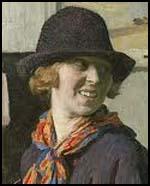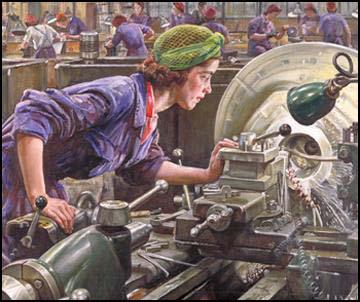Laura Knight

Laura Johnson, the youngest of the three daughters of Charles Johnson and his wife, Charlotte Bates, was born in Long Eaton on 4th August 1877. Her father left the family when she was a child and was brought up by her mother who taught art in a local school.
A talented artist, Laura entered Nottingham School of Art when she was fourteen. While there she met Harold Knight and was deeply influenced by his work. According to her biographer, Janet Dunbar: "Like Harold, Laura was much influenced by the naturalistic methods taught at Nottingham School of Art, and when she went to live in Staithes her studies and painting were all on firmly traditional lines. Also, like him, she entered regularly for the South Kensington College of Art competitions, and won gold, silver, and bronze medals, as well as a Princess of Wales scholarship."
Laura married Knight in June, 1903. Two years later Ernest Brown of the Leicester Galleries gave an exhibition of their work. They sold enough paintings to fund a tour of Europe. On their return they settled in Newlyn, Cornwall. Here they joined a community of artists that became known as the Newlyn School. This included Stanhope Forbes, Elizabeth Forbes, Alfred Munnings, Walter Langley and Frank Bramley.
Laura's painting Daughters of the Sun, exhibited at the Royal Academy in 1909, was praised as a "stunningly effective painting", but priced at £600, it did not sell. She was more fortunate with The Green Feather, that sold to the National Gallery of Canada for £400. Laura later claimed that it only took her a day to paint the picture.
During the First World War, Laura's husband, Harold Knight, was a conscientious objector. Instead of being sent to prison he was directed to work as a farm labourer. After the war the couple left Cornwall and moved to London. In 1922 they moved to St John's Wood, which was to be their permanent home and where each had a studio.
Laura was introduced to Bertram Mills, the owner of Mills's Circus. Janet Dunbar has pointed out: "He gave her permission to go where she liked during rehearsals, and soon she was producing studies of trapeze artists, acrobats, tumblers, jugglers, contortionists, as well as dwarfs, clowns, and the circus animals. She painted a huge canvas, Charivari, which brought in nearly everyone in circus life; it was exhibited at the Royal Academy summer exhibition in 1929 and was caricatured in Punch, with politicians portrayed as the various circus performers."
Laura also produced a long series of oil paintings of the ballet and gipsy life. Knight established herself as the most important woman artist in Britain and in 1936 became the first woman to be elected to the Royal Academy since 1760. However, she was less successful portrait painter and he attempt at capturing George Bernard Shaw was not considered to be successful, either as a likeness or a painting.
In 1936 she published Oil Paint and Grease Paint. Laura was not sympathetic to new ideas in art and she became involved in a dispute with Augustus John, while a member of the selection and hanging committee, over a painting by Percy Wyndham Lewis. Laura refused to back down and John resigned from the academy in protest.
During the Second World War Laura became an official war artist. Her best known painting for the War Artists' Advisory Committee was of a woman munitions worker, entitled, Ruby Loftus Screwing a Breech-Ring. She was also sent to cover the Nuremberg War Crimes Trials.

After the war Harold Knight health declined and the couple decided to move to Colwall. He died there at the Colwall Park Hotel on 3rd October 1961. Janet Dunbar argues: "Laura Knight put on an exhibition of Harold's pictures, and spent her remaining years arranging for exhibitions of her own work. These showed her astounding range in oils, watercolour, etchings, and pencil drawings, with subjects which included landscape, seascape, the Cornish sunlight on nudes, circus scenes, Gypsies, ballet dancers and actors, bomber crews and balloon sites in wartime, and the Nuremberg trial, all executed with incredible facility." Laura published the second volume of her autobiography, The Magic of a Line in 1965.
Laura Knight died at her home in London on 7th July 1970.
